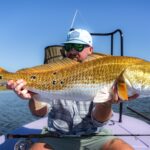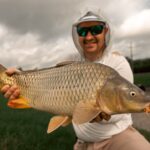
Louisiana Bull Reds Up for Harvest Again: H.B. 604 Must Not Pass
Photo Credit: Carter Abramson | Trevor Johnson Every now and then, we encounter something so
By Tony Friedrich, Vice President and Policy Director
Mark your calendars for January 26th because the Atlantic States Marine Fisheries Commission’s Striped Bass Management Board will meet at 1:30 PM. The details for Amendment 7 are available here (beginning on page 83). We had a chance to review the materials and here’s the rundown. We aren’t going to dive to deep right now because some of these items might be altered during the meeting. There has been a lot of feedback from our readers about how hard this management process is to understand. We heard you. Rather than bog our readers down with issues that might not be in the final document, we decided to get everyone back up to speed on what will happen on the 26th. Keep checking the blog, social media, and The Guide Post after the meeting for a full rundown.
What is Left on the Table?
There are four items left for this meeting and one item that will be addressed at later meetings. A few of these items might turn out to be positive for striped bass management. Some are still filled with potential problems.
Conservation Equivalency (CE)
By this time, our readers know that CE for striped bass has been abused on a cosmic scale by certain states over and over again. CE injects uncertainty into management strategies, which in turn can undermine efforts to protect stripers—something alternatives B, C, and D below try to address. Please understand that there are numerous sub-options for some of the main options. We decided not to include these as they are the most likely to change.
Here are the options on the table right now for CE:
Option A (Status Quo): Board Discretion on Conservation Equivalency Restrictions and Requirements
Option B. Restrict the Use of Conservation Equivalency Based on Stock Status
(Ex. If stock is overfished, CE can’t be used)
Option C. Precision Standards for MRIP Estimates Used in Conservation Equivalency Proposals
(Ex. You can’t use data with a percent standard error [PSE] over a certain percentage)
Option D. Conservation Equivalency Uncertainty Buffer for Non-Quota Managed Fisheries
(Ex. A “luxury tax” for using CE. If a 20% coastwide reduction is needed, states using CE would have to take, say, a 25% reduction)
Option E. Definition of Equivalency for CE Proposals with Non-Quota Managed Fisheries
(Should CE have to adhere to coastwide or state level reductions?)
Rebuilding Plan
The striped bass stock was declared overfished, with overfishing occurring, in 2018. In 2019, the stock assessment was accepted, and two of the five management triggers were tripped. The first trigger tripped was to address overfishing, the rate at which we are removing fish. The second trigger was the one to rebuild an overfished stock. The clock started ticking on the rebuilding plan. According to striped bass management rules, the stock must be rebuilt in 10 years—by 2029. Even though the management board addressed overfishing through Addendum VI, a formal rebuilding plan was never initiated. So, we are behind the 8-ball on this one.
Updates to the stock assessment were delayed due to COVID. In October 2022, we will get updates on spawning stock biomass (SSB) and fishing mortality (F) through 2021. This information is critical to understanding what a rebuilding plan looks like. Right now, we only have information through 2017. We will also be able to understand how effective Addendum VI has been as the 2020 and 2021 data will be included in this update.
There are two options on the table for the rebuilding plan at the meeting in January.
Option A (Status Quo): Rebuild female SSB to the SSB target level by no later than 2029. F rebuild is calculated to achieve the SSB target by no later than 2029 using the standard recruitment method from the stock assessment.
Option B: Rebuild female SSB to the SSB target level by no later than 2029. F rebuild is calculated to achieve the SSB target by no later than 2029 using the low recruitment regime assumption as identified by the change point analysis. This approach is more conservative than Option A.
There is also one other caveat. We will have to wait on the stock assessment update this fall before we fully understand what this plan will look like. Let me explain! There is a chance that the stock is on track to rebuild within ten years already. However, we consider this outcome unlikely due to the poor young-of-year numbers for three consecutive years out of Maryland (one of the reasons for the “low recruitment regime” rebuilding alternative). The more likely outcome is that the stock is in worse shape since the data from 2017. If this is the case, ASMFC will have to initiate an addendum after the stock update to rebuild by 2029. At that juncture, we will only have 5 years to meet this mandate.
The bottom line is we demand a rebuilt stock no matter what the cost. The reality is that because action was not taken in a timely manner, this could prove to be one heck of a fight come October.
Recreational Release Mortality
This issue looks like a lot will come down to the state that you call home. Let’s take a look at the options and you will see why some anglers might get the short end of the stick.
Option A. Status Quo (Addendum VI circle hook measures)
Option B. Effort Controls (Seasonal Closures)
(Ex. This could include no harvest and even no targeting closures)
No targeting closures will prove to be impossible to enforce and even harder to quantify reductions. Here is a quote from the documents at ASMFC.
“It is important to note that fishing trips targeting other species that incidentally catch and release striped bass would still occur regardless of closure type. For example, an average of 24% of all trips interacting with striped bass in 2018 and 2019 were non-targeted trips or trips where striped bass was the secondary target species. These trips would likely still occur during a striped bass no-targeting closure. Additionally, seasonal closures for striped bass may shift effort to targeting other species or to other times of year when the striped bass fishery is open.”
Option C. Additional Gear Restrictions
Option D. Outreach and Education
Management Triggers
We left the best for last. Management triggers take up over ten pages in the draft document (see p. 135-147). Explaining each one would be a several-thousand-word blog. Rather than do that to you, we think it is more productive to let you know that this is the area of biggest concern for us. The debate will rage on the 26th over how to weaken or strengthen each of the five triggers. We have no idea what will be removed or included in the final draft of Amendment 7 released for public comment. Let’s address this after the meeting.
One Other Option
During the last meeting, there was a discussion about protecting the 2015 year class. After the numbers were run, the Technical Committee found that this effort will have little or no impact on rebuilding the stock:
“These results indicate that changing the selectivity does not have a significant impact on rebuilding the stock if the F [fishing mortality] rate remains constant. If the goal is to expedite stock rebuilding, controlling the overall F rate is more important than only changing the selectivity. “
We can expect this to be removed from Amendment 7.
So that is the rundown. We will update you on all the important information after the meeting. Please be a part of the solution. Complaining on social media will do nothing. Because of an avalanche of comments during the Public Information Document process, we were able to remove many of the worst options. In other words, you made a difference. You are going to need to do this all over again in February and March during the public hearings and comment process.
We are always asked, “What can I do to help?” Well, this is it. This is what you must do. Participate in the process. Comment during the hearings. If you do this, we can save striped bass.

Photo Credit: Carter Abramson | Trevor Johnson Every now and then, we encounter something so

This past weekend, ASGA proudly sponsored the Dirty Carp Tournament in Louisiana — and no, you didn’t misread that.

After years of data pouring in from The Albie Project, advocacy, persistence, and support from

This morning, the Connecticut Environment Committee held a hearing on House Bill 6248, a bill
We rely on our members and donations to keep fighting for a sustainable tomorrow in marine conservation.
GIVE THE GIFT OF FISHERIES CONSERVATION THIS HOLIDAY SEASON. SHOP ASGA GOODS THAT FUND FISHERIES RESEARCH & ADVOCACY CAMPAIGNS
JOIN ASGA IN CALLING FOR CRITICAL MANAGEMENT ACTION AFTER YEARS OF SPAWN FAILURES & POOR MANAGEMENT.
By using this website, you agree to our use of cookies. We use cookies to provide you with a great experience and to help our website run effectively. To learn more, please review our privacy policy.
3 Responses
Thank you for this post as it is very helpful in sorting out all the complexities of what is going on. Your time is appreciated!
Agenda:
https://www.asmfc.org/files/Meetings/2022WinterMeeting/AtlanticStripedBassBoard_Jan2022.pdf
Sign up for Meeting Webinar:https://register.gotowebinar.com/register/8463911188401300749
Thank you. Excellent breakdown. Will comment during the comment period. As a Chesapeake watershed striper fisherman, I am willing to have a moratorium if that’s what it takes. At a minimum the CE in MD has to be stopped. Really should stop the commercial striper fishery in the bay. And for us recreational fishers… Go 1 over 36 or go no- kill, barbless, no trebles, circles only for bait, whatever it takes. Many charters will scream – the fear is understandable- but they’ll be out of business when the stripers are gone, which appears to be where we are headed under current practices.